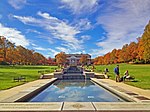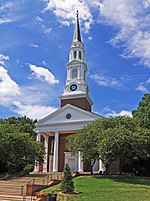University of Maryland College of Arts and Humanities
1917 establishments in MarylandLiberal arts colleges in MarylandUniversities and colleges established in 1917University of Maryland, College Park
The College of Arts and Humanities is one of the 13 schools and colleges at the University of Maryland, College Park. It is a liberal arts program that studies human experience, thought, expression, and creativity. It was one of the seven schools established in 1917 by Albert F. Woods.The College of Arts and Humanities consists of 14 academic departments with 28 academic majors and 33 academic minors. There are 3,549 undergraduate and graduate majors. The College of Arts and Humanities is housed within 12 academic buildings on campus. The college itself is located in Francis Scott Key Hall.
Excerpt from the Wikipedia article University of Maryland College of Arts and Humanities (License: CC BY-SA 3.0, Authors).University of Maryland College of Arts and Humanities
Branchville Road,
Geographical coordinates (GPS) Address Website Nearby Places Show on map
Geographical coordinates (GPS)
| Latitude | Longitude |
|---|---|
| N 38.98496 ° | E -76.94272 ° |
Address
University of Maryland, College Park (UMD)
Branchville Road
20742
Maryland, United States
Open on Google Maps





